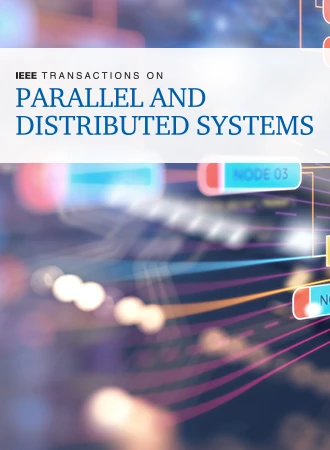Cube-fx: Mapping Taylor Expansion Onto Matrix Multiplier-Accumulators of Huawei Ascend AI Processors
IF 5.6
2区 计算机科学
Q1 COMPUTER SCIENCE, THEORY & METHODS
IEEE Transactions on Parallel and Distributed Systems
Pub Date : 2025-04-03
DOI:10.1109/TPDS.2025.3557444
引用次数: 0
Abstract
Taylor expansion, a mature method for function evaluations used in Artificial Intelligence (AI) applications, approximates functions with polynomials. In addition to the function evaluations, AI applications require massive matrix multiplications, inspiring manufacturers to propose AI processors with matrix multiplier-accumulators (MACs). However, compared with the powerful Matrix MACs, the vectorized units of the AI processors cannot efficiently carry the existing Taylor expansion implementation of Single Instruction Multiple Data (SIMD) parallelism. Leveraging the Matrix MACs for Taylor expansion becomes an ideal direction. In previous studies, migrating optimized algorithms to the Matrix MACs requires matrix generation during the runtime. The generation is expensive and even cancels the accelerations brought by the Matrix MACs on the AI processors, which Taylor expansion also suffers. This article presents Cube-fx, a mapping algorithm of Taylor expansion for multiple functions onto Matrix MACs. Cube-fx expresses the building and computation in matrix multiplications without inefficient dynamic matrix generation. On Huawei Ascend processors, Cube-fx averagely achieves 1.64× speedups compared with vectorized Horner’s Method with 56.38Cube-fx:将泰勒展开映射到华为Ascend AI处理器的矩阵乘法器-累加器上
泰勒展开是一种成熟的用于人工智能(AI)应用的函数评估方法,它用多项式逼近函数。除了功能评估之外,人工智能应用还需要大量的矩阵乘法,这促使制造商提出带有矩阵乘法累加器(mac)的人工智能处理器。然而,与功能强大的Matrix mac相比,AI处理器的矢量化单元无法有效地承载现有的单指令多数据(SIMD)并行的Taylor展开实现。利用矩阵mac进行泰勒展开成为一个理想的方向。在以往的研究中,将优化算法迁移到矩阵mac需要在运行时生成矩阵。这一代是昂贵的,甚至抵消了矩阵mac在AI处理器上带来的加速,这也是泰勒扩展所遭受的。本文提出了一种多函数泰勒展开到矩阵mac上的映射算法Cube-fx。Cube-fx以矩阵乘法的方式表达构建和计算,而不需要低效的动态矩阵生成。在华为Ascend处理器上,Cube-fx与向量化霍纳方法相比,平均速度提高了1.64倍,减少了56.38%的向量化运算。
本文章由计算机程序翻译,如有差异,请以英文原文为准。
求助全文
约1分钟内获得全文
求助全文
来源期刊

IEEE Transactions on Parallel and Distributed Systems
工程技术-工程:电子与电气
CiteScore
11.00
自引率
9.40%
发文量
281
审稿时长
5.6 months
期刊介绍:
IEEE Transactions on Parallel and Distributed Systems (TPDS) is published monthly. It publishes a range of papers, comments on previously published papers, and survey articles that deal with the parallel and distributed systems research areas of current importance to our readers. Particular areas of interest include, but are not limited to:
a) Parallel and distributed algorithms, focusing on topics such as: models of computation; numerical, combinatorial, and data-intensive parallel algorithms, scalability of algorithms and data structures for parallel and distributed systems, communication and synchronization protocols, network algorithms, scheduling, and load balancing.
b) Applications of parallel and distributed computing, including computational and data-enabled science and engineering, big data applications, parallel crowd sourcing, large-scale social network analysis, management of big data, cloud and grid computing, scientific and biomedical applications, mobile computing, and cyber-physical systems.
c) Parallel and distributed architectures, including architectures for instruction-level and thread-level parallelism; design, analysis, implementation, fault resilience and performance measurements of multiple-processor systems; multicore processors, heterogeneous many-core systems; petascale and exascale systems designs; novel big data architectures; special purpose architectures, including graphics processors, signal processors, network processors, media accelerators, and other special purpose processors and accelerators; impact of technology on architecture; network and interconnect architectures; parallel I/O and storage systems; architecture of the memory hierarchy; power-efficient and green computing architectures; dependable architectures; and performance modeling and evaluation.
d) Parallel and distributed software, including parallel and multicore programming languages and compilers, runtime systems, operating systems, Internet computing and web services, resource management including green computing, middleware for grids, clouds, and data centers, libraries, performance modeling and evaluation, parallel programming paradigms, and programming environments and tools.
 求助内容:
求助内容: 应助结果提醒方式:
应助结果提醒方式:


